Continued from Page One:
USS Macon Expedition 2006
By Dr. Robert V. Schwemmer, NOAA
(With contributions from Bruce Terrell and Chris Grech; NOAA, MBARI, photos;
Published in NOON BALLOON #72)
Five of the Macon’s eight German-built Maybach VL-II 12 cylinder gasoline engines were identified, including one of the Allison propeller transmissions with 19.5-foot connecting shaft. The Maybach engines were easily distinguishable since the 12 spark plug wires were still visible and are in some cases still attached to the distributor.


[Producer’s caption: The mighty Mybachs, then with Dr. Karl Arnstein, and 70 + years later. ]
Objects from the ship’s galley were recorded, including plastic serving ware, two sections of the stove with propane tanks, and the enlisted men’s dining table and bench.
Debris Field B contained the Macon’s bow section including the mooring assembly. This field also contains aluminum chairs, file cabinet, and desks that may have been from the officers’ or meteorologist’s office. Both debris fields contained duraluminum girders, several gasoline fuel tanks and portions of the eight water-recovery condensers. (END)
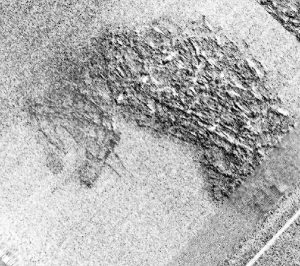

[Producer’s caption: Digital composites of the two main debris fields, A [left] and B. The Macon’s stern assemblies, including the remains of the shattered upper fin, have not been located. It is believed the stern has settled in a deeper area on a slope that has been considered too hazardous to safe ROV exploration.]

[Producer’s caption: MBARI pieced together numerous images, taken at close-up distances for illumination to be practical, to produce this mosaic of the remains of Bay VII’s hangar bay. Structure, as well as what’s left of the trapeze, are visible. At least one wheel/tire assembly has been photographed detached, verifying there had not been time to re-attach all, in any, of the landing gear before the ship was damaged.]

[Producer’s caption: This view of the Navy deep-diving sub Sea Cliff taken during the first manned dive on the site in 1990 illustrates just how close Macon was to making it back to shore. One can only speculate what might have happened if Macon had made a grounding, even damaged as she would have been on that rocky Point Sur coastline.]
The Significance of the USS Macon Archaeological Survey
By Bruce G. Terrell, Senior Archaeologist
NOAA/Nat’l Marine Sanctuary Program
(reprinted from NOON BALLOON)
In a sense, NOAA’s 2006 mission to the site of the USS Macon began with the MBARI and US Navy’s 1990 and 1991 expeditions. NOAA was, at that time, in the final stages of designating the Monterey Bay National Marine Sanctuary (MBNMS) and the Macon news alerted the program that there was a significant resource in the new sanctuary’s waters.

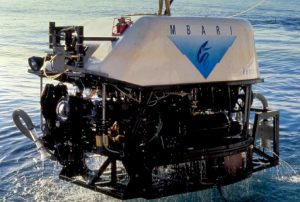
[Producer’s caption: MBARI’s ship and ROV used in the 1991 explorations.]
The USS Macon is perhaps the best-protected archaeological resource in U.S. waters today. It rests in the waters of NOAA’s MBNMS and is protected by the National Marine Sanctuaries Act. It is owned by the U.S. Navy and is also protected from looting by the Sunken Military Craft Act. Finally, it rests on California state bottomlands which also entitles it to protection from illegal disturbance. The Monterey Bay National Marine Sanctuary, like all of NOAA’s fourteen sanctuaries, is responsible for the identification, protection and management of historical and archaeological resources. The USS Macon mission provides the first comprehensive documentation of all of the known distribution of wreckage. When completed, the video mosaic will allow NOAA to interpret the archaeological context and inter-relationship of the site’s features. At over 1500 feet, the depth of the Macon’s wreckage has kept if safe from salvage and pilferage, as well as from the bottom dragging nets of fishing boats. Commercial fishing can be devastating to submerged archaeological remains. Macon is also in an area of the California coast where bottom dragging is presently prohibited.


[Producer’s Caption: With 110 gasoline tanks, and a host of other tanks for cooling water, lube oil and ballast water, the ocean floor is littered with lightweight tanks, some that originally weighed as little as 22 lbs. Below, one is barely crushed; others, horizontal mounted, badly imploded, baffles visible.]

Feature identification has already begun with NOAA and MBARI consulting with the airship experts from the Naval Airship Association. The construction of airships was well documented and the many contemporary photographs are now useful in identifying objects.
The archaeological team expects to publish a final mission report by the end of summer ’07. The report will contain a final assessment of site features and distribution. It will also present site management recommendations for both the Navy and the sanctuary to consider. Finally, the team expects to begin the process of nominating the USS Macon to the National Register of Historic Places. Since the Macon site most likely holds the most complete archaeological record of a unique naval aviation resource, it should be considered to be unique and of national significance.

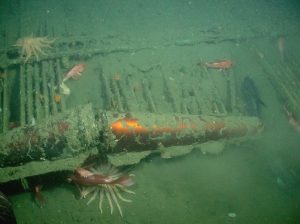
[Producer’s Caption: one water-recovery condenser is laid out on the ocean floor as if a railroad track. Note that half of the pipe appears bright brass and the other darker, as if dissimilar metal. Likely, a trick of the light.]
Although the Macon mission was actually a standard archaeological assessment project for the National Marine Sanctuaries Program, the uniqueness of the subject created international interest. The project had a useful education and outreach value and brought many new constituents an awareness of the varied ocean issues that are addressed by the sanctuaries everyday. (END)
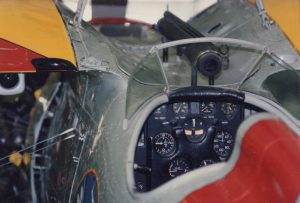

[Producer’s caption: The NASM’s Sparrowhawk #9056 offers a reference for examination of the remains in Macon’s hangar bay. The turnbuckle-equipped hook release pull is intact, while the fragile windscreen and its framework are gone. Note that the black highlight around the pilot’s handgrips (the compass is seen below the left grip) are still somewhat visible after decades in the deep.]
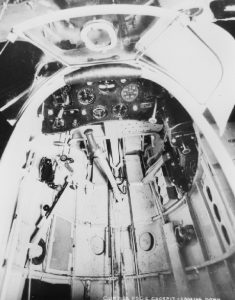

[Producer’s Caption: Remembering the Curtiss Sparrowhawk came in to being as airplanes were evolving from wooden ribs and tube-and-canvas structures, the F9C-2’s revolutionary monocoupe metal fuselage and stamped metal wing ribs have held up remarkably well given the 70+ years below a 1/4 mile of salt water. The company’s well known cabin monoplane, their 1929 Robin, made famous for endurance flying in the 1930s, was their first production airplane with stamped metal wing ribs. Not only did aviatrix Bobby Trout and “Wrong Way” Doug Corrigan fly Robins, the incredible 29-day Robin flyer “Ol Miss” is enshrined at NASM downtown, while Sparrowhawk 9056 sits on its wheels over at Dulles.]
In ZRS the movie, we are planning on having a “feature after the feature” to liven up the credits rolling. Of course there is only black and white footage of the real flying carriers; however, some of it was transferred to safety film before nitrate would have lost the images forever. Of this, some is available as fine grain 35mm film stock, which when projected with modern 4K equipment would hold its own on the big screen. While most stock film houses demand more money than would be practical to spend on the after-feature credit roll, those in the Fox-Movietone out-take archive at the University of South Carolina, Columbia, are of high quality and are more reasonably priced. Contrasting the 1930s footage, the opposite side of the credit screen could feature the best of the MBARI hi-def footage taken during their last expedition. The producer, after having spent years studying the subject and gathering images of anything LTA or hook-on, remembers vividly the first time in 1990 when a shot of the cockpit so seemingly familiar suddenly looked back—since a rock cod had taken refuge just under what was left of the glareshield. Thus the film will end with the harsh reality—and interesting beauty—of the real world of the flying carrier before it completely disintegrates.
